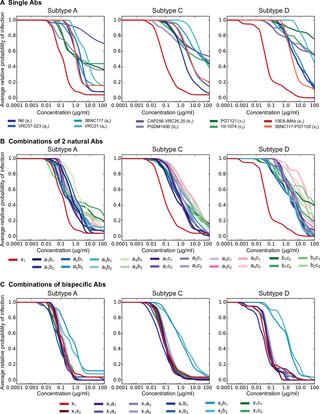PLoS Pathogens ( IF 5.5 ) Pub Date : 2018-03-05 , DOI: 10.1371/journal.ppat.1006860 Kshitij Wagh 1, 2 , Michael S Seaman 3 , Marshall Zingg 3 , Tomas Fitzsimons 3 , Dan H Barouch 3 , Dennis R Burton 4 , Mark Connors 5 , David D Ho 6 , John R Mascola 7 , Michel C Nussenzweig 8 , Jeffrey Ravetch 9 , Rajeev Gautam 10 , Malcolm A Martin 10 , David C Montefiori 11 , Bette Korber 1, 2

|
There is great interest in passive transfer of broadly neutralizing antibodies (bnAbs) and engineered bispecific antibodies (Abs) for prevention of HIV-1 infections due to their in vitro neutralization breadth and potency against global isolates and long in vivo half-lives. We compared the potential of eight bNAbs and two bispecific Abs currently under clinical development, and their 2 Ab combinations, to prevent infection by dominant HIV-1 subtypes in sub-Saharan Africa. Using in vitro neutralization data for Abs against 25 subtype A, 100 C, and 20 D pseudoviruses, we modeled neutralization by single Abs and 2 Ab combinations assuming realistic target concentrations of 10μg/ml total for bnAbs and combinations, and 5μg/ml for bispecifics. We used IC80 breadth-potency, completeness of neutralization, and simultaneous coverage by both Abs in the combination as metrics to characterize prevention potential. Additionally, we predicted in vivo protection by Abs and combinations by modeling protection as a function of in vitro neutralization based on data from a macaque simian-human immunodeficiency virus (SHIV) challenge study. Our model suggests that nearly complete neutralization of a given virus is needed for in vivo protection (~98% neutralization for 50% relative protection). Using the above metrics, we found that bnAb combinations should outperform single bnAbs, as expected; however, different combinations are optimal for different subtypes. Remarkably, a single bispecific 10E8-iMAb, which targets HIV Env and host-cell CD4, outperformed all combinations of two conventional bnAbs, with 95–97% predicted relative protection across subtypes. Combinations that included 10E8-iMAb substantially improved protection over use of 10E8-iMAb alone. Our results highlight the promise of 10E8-iMAb and its combinations to prevent HIV-1 infections in sub-Saharan Africa.
Trial registration
ClinicalTrials.gov NCT02960581
中文翻译:

常规和双特异性广泛中和抗体预防 HIV-1 A、C 和 D 亚型感染的潜力
人们对被动转移广泛中和抗体 (bnAbs) 和工程双特异性抗体 (Abs) 以预防 HIV-1 感染非常感兴趣,因为它们的体外中和广度和对全球分离株的效力和长的体内半衰期。我们比较了目前处于临床开发阶段的八种 bNAb 和两种双特异性抗体及其 2 种抗体组合在预防撒哈拉以南非洲主要 HIV-1 亚型感染的潜力。使用针对 25 种 A 亚型、100 C 和 20 D 假病毒的 Abs的体外中和数据,我们模拟了单个 Abs 和 2 Ab 组合的中和作用,假设 bnAbs 和组合的实际目标浓度为 10μg/ml,双特异性抗体为 5μg/ml . 我们用IC80广度效力、中和的完整性以及两个 Abs 在组合中的同时覆盖作为表征预防潜力的指标。此外,我们根据猕猴-人类免疫缺陷病毒 (SHIV) 挑战研究的数据,通过将保护建模为体外中和功能,预测Abs 和组合的体内保护。我们的模型表明,体内需要几乎完全中和给定病毒保护(约 98% 中和 50% 相对保护)。使用上述指标,我们发现 bnAb 组合应如预期的那样优于单个 bnAb;然而,不同的组合对于不同的亚型是最佳的。值得注意的是,针对 HIV Env 和宿主细胞 CD4 的单个双特异性 10E8-iMAb 优于两种常规 bnAb 的所有组合,预测的跨亚型相对保护率为 95-97%。与单独使用 10E8-iMAb 相比,包含 10E8-iMAb 的组合大大改善了保护。我们的结果突出了 10E8-iMAb 及其组合在撒哈拉以南非洲预防 HIV-1 感染的前景。
试用注册
ClinicalTrials.gov NCT02960581











































 京公网安备 11010802027423号
京公网安备 11010802027423号